Since losing his companion, the male has followed a fairly regular pattern of spending nights in a secluded corner of our birding patch the wetlands adjacent to our home, just this side of the patch of green trees in the background. Notice that the water levels have receded enough to allow the ATVs to trespass at will into the posted "protected" wetlands.
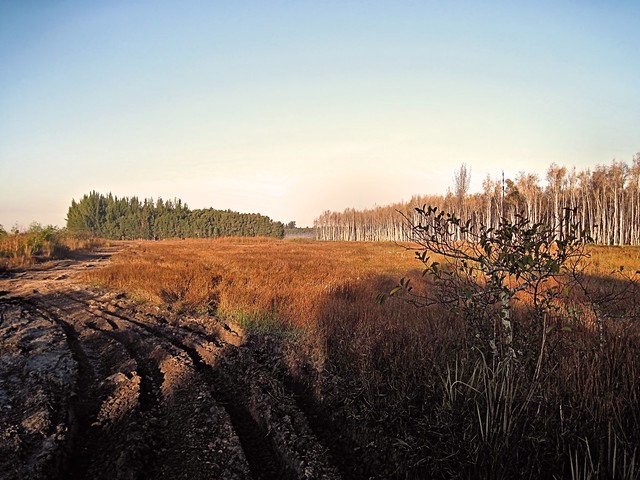
He is barely visible unless he emerges from behind the cattails that encircle a small pond which surely provides a food source.
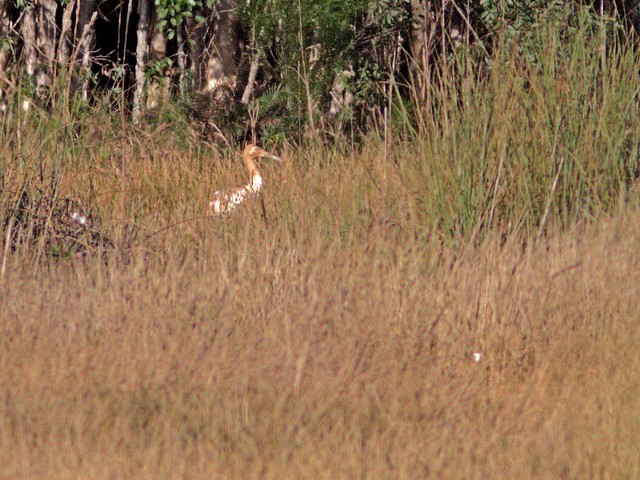
He usually flies out about 30 to 45 minutes after sunrise, and heads for a residential area just north of our home. Although the International Crane Foundation recommends that humans should not approach any closer than 200 yards, the bird often spends much of the day in the same spot, a broad patch of lawn between two homes. When I first saw him there he was standing right next to the sidewalk. I took these photos from the other side of the street, only about 40 feet away. I was impressed at how tall he is.

A pedestrian walked by, his posture suggesiting that he was deeply in thought or meditating. He seemed not to even see the crane, less than 10 feet away.

I am concerned about the survival chances of a lone bird. Many species, notably geese and Sandhill Cranes, forage with others of their kind, but one member of the group always has its head up high looking for danger.This crane forages on a lawn that is certainly laced with fertilizer, herbicides and possibly pesticides.He has been seen eating acorns, but they are now in short supply, so they are not a reliable food source. Most of the wetlands are dried up. Earlier it had foraged along the canals but they are mostly dry. The receding water levels of the lakes and canals do provide rather extensive areas of exposed mud that attracts other birds.
One morning this week as we walked out before sunrise, the fog was lifting just above Mary Lou's head.

Only a few minutes later, the male surprised us by flying up from his overnight resting area just as the sun was coming up.He headed directly towards the residential subdivision, which is just north of our home. Eleven minutes later, instead of following his usual habit of staying there for much of the morning, he returned to the prairie location, and disappeared behind the stand of cattails, remaining there for over a half hour before once again flying up towards the cluster of homes.

After he flew over the wires behind the houses, he turned back 180 degrees and headed towards me, landing at the east shore of the lake in the conservation easement/mitigation area that we call our birding patch..
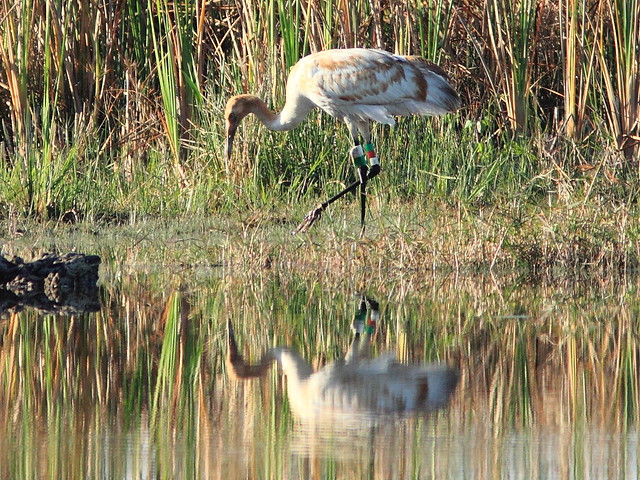
The crane preened, then foraged actively.

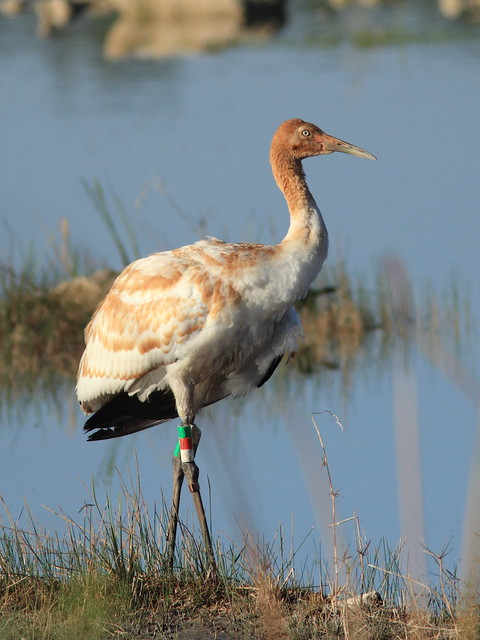
I could not identify its prey. Boat-tailed Grackles were in abundance, and they were finding food in the mud along the shore. White Ibises, Tricolored and Little Blue Herons as well as Great and Snowy Egrets were taking aquatic prey. I hid next to a clump of high grass, and the crane seemed not to notice me. The crane exhibited more situational awareness than when it was in the residential area. When the other waders and blackbirds suddenly flushed (I am not sure why, but they acted as if an eagle, harrier or Peregrine flew over), the crane became very alert and held his head high. He looked up into the sky as a gull flew over.
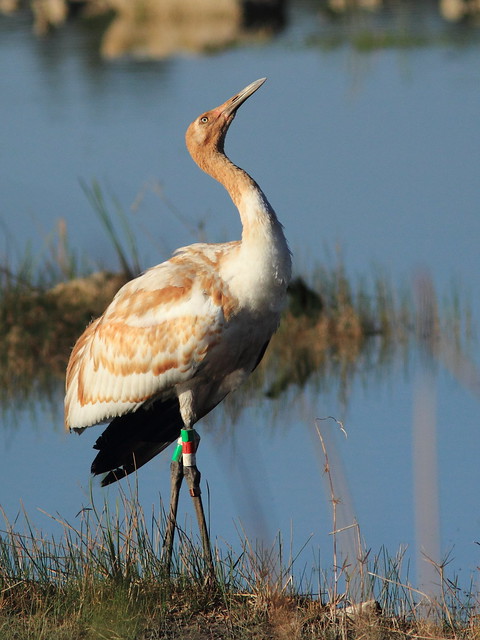
Then he seemed to notice me and kept looking my way. Soon afterward he took flight and disappeared in the direction of his nighttime resting spot on the wet prairie.
Great serie of photos of this crane. This is a new bird for me!
ReplyDeleteGreat post on the continuing saga of the crane. I sure hope he makes it.
ReplyDeleteGreat series of images!
poor lonely one. i hope he makes it (and i hope the female can recover and rejoin him!)
ReplyDeleteWow these are awesome shots! I only have one goose left after last week and I am concerned about the same thing.
ReplyDeleteSo far he is staying close to our two Mallards and feeding with them. I hope he makes it!
I really enjoyed these pictures and pray the poor guy makes it!
Happy weekend! :-)
A sad and beautiful story! Love these photos - especially the one with the fluffed feathers and the one with head held high as if determined to survive! A wonderful post!
ReplyDeleteI like the shot of him looking up. And I'm always amazed by what people don't notice and just walk by. Or maybe he thought the crane was a lawn ornament.
ReplyDeleteBeautiful photos of the crane, Ken! I feel sorry for the bird being alone. I hope it finds its way and joins in with a group. Great post.
ReplyDeleteGreat sighting!! Boom & Gary of the Vermilon River, Canada.
ReplyDeleteGreat image series showing Ken. Ønser you a good Sunday :) Hanne Bente
ReplyDeleteI do hope that he is being watched and everything is recorded in case he needs to be 'helped' out for surviving. Even if it's in a zoo type environment,...but let's hope not. Pray he returns to the fold of the flock and his female companion is mended well enough to return also.
ReplyDeleteExcellent images.
UPDATE: This chapter of the crane saga has ended with his safe capture this morning. He has already been released to join a flock of his own species near Lake Okeechobee. The female required amputation of a toe but has recovered and was released in Tennessee. See the FLICKR photostream in the right panel.
ReplyDeleteTerrific captures. I often wonder if the banding inhibits the birds in any way. I am glad he was reunited with his own kind.
ReplyDeleteGreat photos of a magnificent bird. I am so glad that he has been relocated to a safer habitat. btw - I wish ATV's had never been invented!!
ReplyDeleteGreat pictures - and glad to read the update above.
ReplyDeleteIts clear that it is a well studied crane!
Cheers and thanks for linking to WBW
Stewart M - Melbourne
Lovely story of this lone creature. Did his companion survive, won't they bring it back so they can pair up again? Thanks for sharing!!
ReplyDeleteOh just after I posted I see the update that he has been moved. Thanks for the update!
ReplyDeleteAn engrossing story Ken and I was wondering of course if he was missing his mate to which I answered "yes, of course". I just read your Update and it is almost certainly the best outcome in the circumstances. Your shots of the crane are just spot on. Interesting how even such a large bird looks up in the sky for incoming predators.
ReplyDeleteBeautiful photos! Glad to read about the happy outcome for both birds.
ReplyDeleteThanks, all, for visiting and providing such interesting comments. I am back in Illinois with limited Internet connection and very cold temperatures!
ReplyDeleteJust got word that female #13 has died, and at this time the location of male #15 is unknown.
ReplyDelete